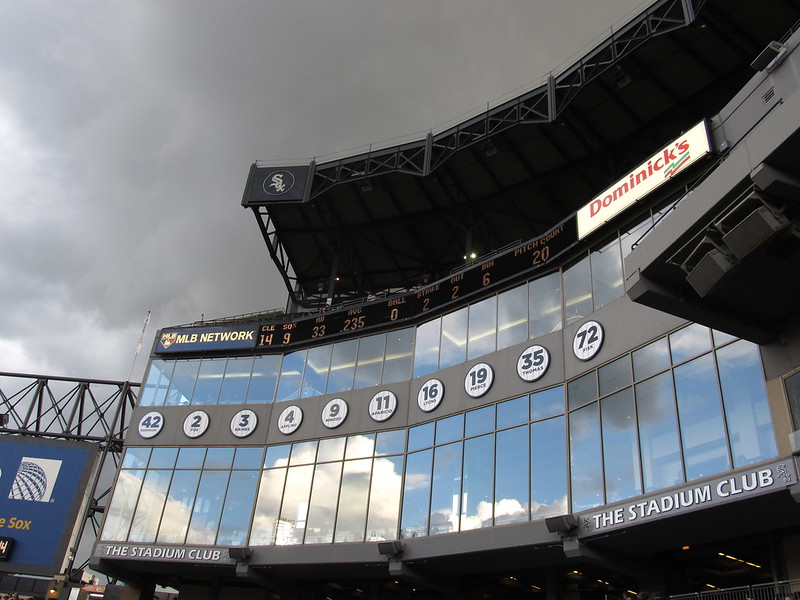For certain players, having their jersey number retired by their home team is one of the greatest honors they can receive. It’s the team’s way of expressing to players that they will always be considered one of the family and that their fans and the franchise appreciate their contributions.
About 200 players have had their numbers retired by a team, some by more than one. The Yankees have the most retired numbers, while the Marlins have none.
Although a number-retiring ceremony may not be as historic as a Hall of Fame ceremony, it is usually just as rewarding for the player, the fans and the team. In 2024, the Mets retired the numbers worn by pitcher Doc Gooden (16) and outfielder Darryl Strawberry. (18). This summer, the Pirates retired the number 10 worn by their beloved Hall of Fame former manager Jim Leyland.
Photo by Ken Lund | Retired Numbers, U.S. Cellular Field (Comiskey Park), Chicago, Illinois
Who are those guys?
Few fans know much about the numbers of those retired beyond those on their favorite team, nor do they know much about the thinking behind the decision...why this player but not that one, for instance.
There are no requirements or guidelines for retiring a number. It is up to the team. The player does not have to be in the Hall of Fame, be deceased or have been retired for a set number of years to have his number retired by the team he played for.
There’s also no standard for displaying retired numbers. Most place the player’s number and last name on a placard on the outfield wall. The Cubs fly special flags on the foul poles, showing each player’s name and number.
The first retired number: Lou Gehrig’s #4
Lou Gehrig, who wore number 4 for the New York Yankees, was the first player to have his number retired; his number was retired on April 9, 1939, when the Yankees said farewell to the Iron Horse by declaring it Lou Gehrig Day. Sadly, Gehrig could not defeat ASL—which, as we all know, is called Lou Gehrig’s disease. That day was also when Gehrig made his famous emotional farewell speech, saying that despite what had happened, he considered himself the “luckiest man on the face of the earth.”
Here’s what’s interesting: Numbers on uniforms didn’t start until 1929, and the Yankees started it. (The Indians had tried it many years earlier, but it didn’t catch on.) The numbers on that 1929 Yankees team were assigned by batting order. That’s why Ruth was #3. And Gehrig, who hit cleanup, was #4.

Photo by Wally Gobetz 2006 | Fenway Park: Retired Numbers
What about the great players who never wore a number?
Baseball has existed since the late 1800s, so many famous and significant players never wore a number. In those cases, the teams retroactively acknowledge the players by displaying their names in the stadium alongside the other retired players.
That’s the case with the Cardinals’ Rogers Hornsby, John McGraw and Christy Mathewson, the Giants’ Chuck Klein and the Phillies’ Grover Cleveland Alexander.
Several older star players performed without numbers for the Detroit Tigers: Ty Cobb being the most famous. Because of that, the franchise took the stance for years that no Tiger player’s number should be retired because they couldn’t retire a number for Cobb—the “Greatest Tiger of All.” That changed when they decided to retire Al Kaline’s #6 in 1980. Cobb has a memorial plaque near the entrance to Tiger Stadium, and it was presented in the early 1960s.
Two-timers: players with retired numbers for two or more teams
A handful of great players have had their number(s) retired for more than one team. That’s because they made a significant and memorable impact on each team, and (or) they had such a distinguished baseball career that the teams wanted to retire the player’s number and claim to the fans, “He played here. He was one of us.”
Here are those players:
- Reggie Jackson
- Yankees (44)
- Athletics (9)
- Roy Halladay
- Blue Jays (32)
- Phillies (34)
- Greg Maddux
- Braves and Cubs (31)
- Rod Carew
- Angels and Twins (29)
- Nolan Ryan
- Angels (30)
- Astros and Rangers (34)
- Carlton Fisk
- Red Sox (27)
- White Sox (72)
- Frank Robinson
- Orioles and Reds (20)
By the numbers
As you might have guessed, the teams that have retired the most numbers fall into one or all of the following categories, or are a combination of them:
- Older, established teams
- Traditionally successful franchises with a legacy of winning
- Big market teams that attract or acquire top talent
- Teams with a fervent fan base who embrace the team and its stars
Yankees, 22: The Bronx Bombers lead the Majors with 22 retired numbers, including all numbers from 1 to 10 (all famous Yankees). In order from 1 to 10, they are: Billy Martin, Derek Jeter, Babe Ruth, Lou Gehrig, Joe DiMaggio, Joe Torre (as manager), Mickey Mantle, Yogi Berra and Bill Dickey, Roger Maris, and Phil Rizzuto. Honorary plaques include those for Joe McCarthy and Miller Huggins.
Cardinals, 13. The Cards have retired 13 player numbers and have acknowledged the great Rogers Hornsby and announcer Jack Buck. In addition to Ozzie Smith, Stan Musial, Bob Gibson and Lou Brock, they’ve retired two manager’s numbers: Tony LaRussa (10) and Whitey Herzog (24).
Dodgers, 11. The list of Dodgers and their retired numbers starts off with the most famous: Jackie Robinson, #42. The ’60s pitching duo of Drysdale and Koufax stand out, sluggers Duke Snider and Roy Campanella, two Hall of Fame managers—the quiet Walter Alston and the not-so-quiet Tommy Lasorda. Beloved announcers Vin Scully and Jaime Jarrín have also been honored.
#42: Jackie Robinson’s number permanently retired by MLB
On April 15, 1997, the 50th anniversary of Jackie Robinson’s debut as a Brooklyn Dodger, the Dodgers retired his number, 42, in a special ceremony at Dodger Stadium. Commissioner Bud Selig announced that Robinson’s number would be permanently retired throughout baseball. It remains the only one retired by every MLB team. Robinson’s debut in 1947 changed the game forever by breaking the color barrier that had existed until then.
Starting in 2009, every player and coach on all MLB teams wears No. 42 in honor of Robinson on Jackie Robinson Day, April 15th.
Who’s next?
Who knows! It will most likely be a recently retired star, perhaps one who was inducted into the Hall of Fame.
Still, with players changing teams so often and quickly, it doesn’t give time to establish a legacy with any team. You can see a list of every team’s retired numbers at MLB.com.
Resources: mlb.com/news/every-mlb-team-retired-numbers; en.wikipedia.org/wiki/retired_numbers; cbssports.com/mlb/news/yankees-special-request-on-retired-numbers; bleachernation.com/chicago-cubs-retired-numbers; baseballhall.org/jackie-robinson-number-retired-throughout-baseball; 12news.com/article/sports/mlb/why-all-mlb-players-wearing-42

